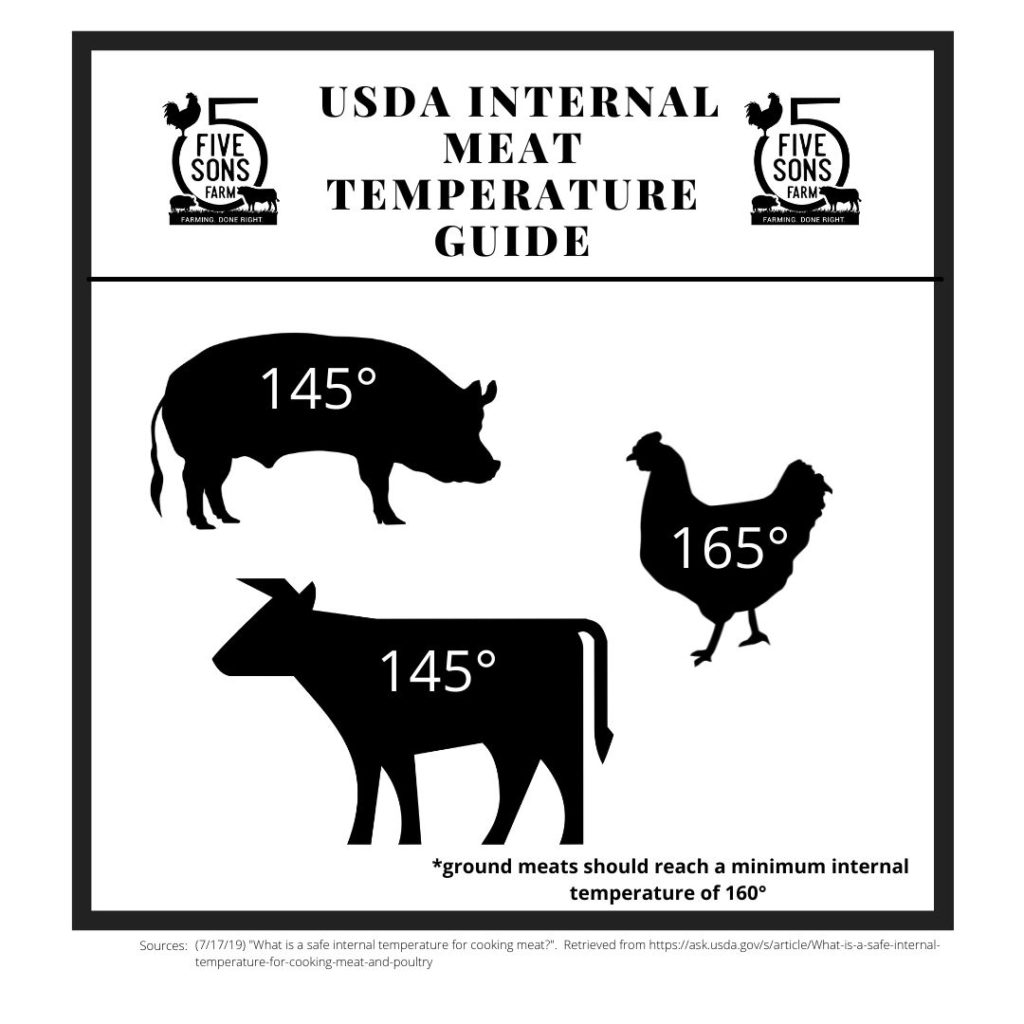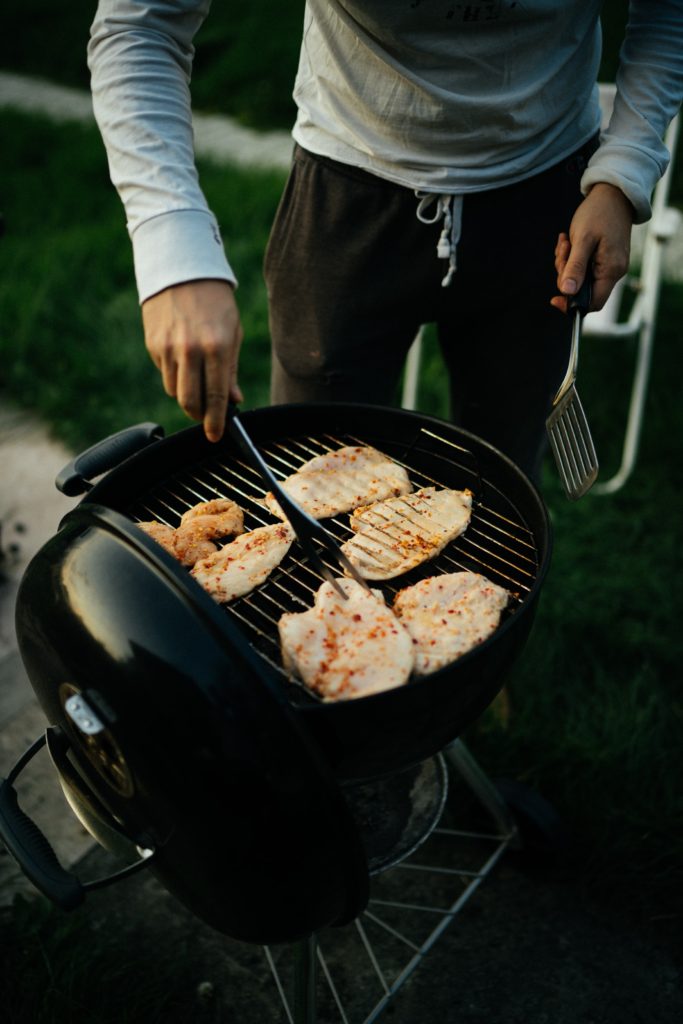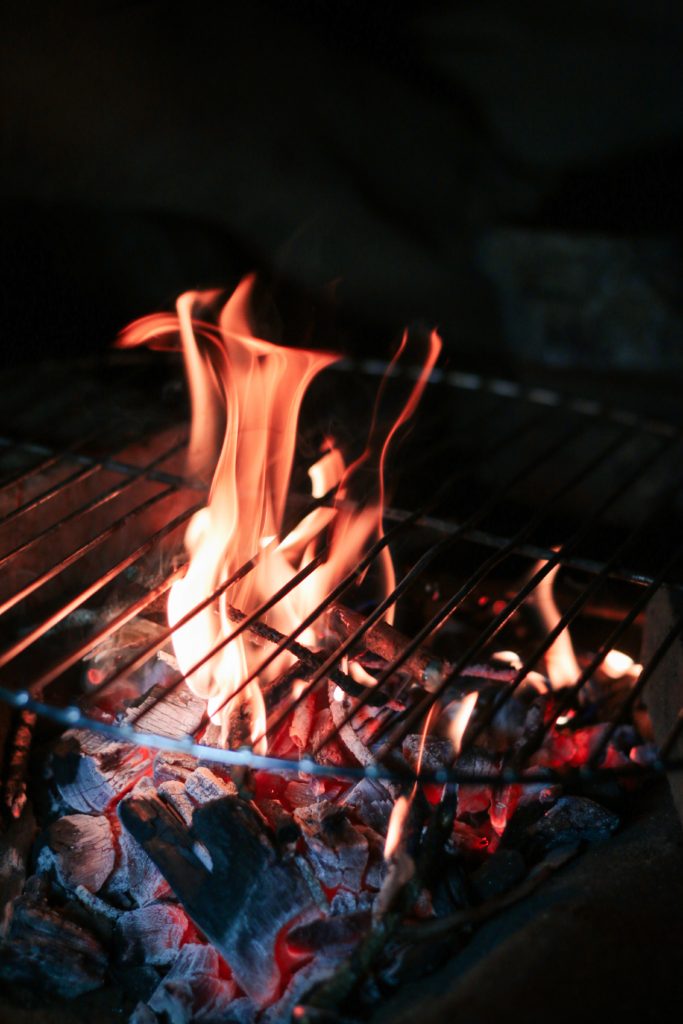Impress your friends at your backyard BBQ with these 8 tips to improve your grill skills.

When summer comes around each year, there are not many meals I look forward to more than a backyard BBQ. If you live in The South as we do, then you’ve never called it a barbeque. Ever. We call it “grillin’ out”, and like most Southern gatherings we host it potluck style. When it comes to a backyard BBQ in The South, we keep things simple. Paper plates are piled high with various forms of smoked or grilled meat. The drink station will ALWAYS have sweet tea. No need for a fancy ice bucket, there will usually be a cooler just for ice and another for canned drinks. We serve our barbecue with carbs! You’ll be hard-pressed to find a southern barbecue without potato salad. Sometimes, especially if you’re at a family gathering, you’ll need a second plate just for side dishes. If you really want to make a southern woman beam with pride, then go back for seconds.
(Psst. PRO TIP: The best gossip goes down in the kitchen. Especially if your cousin’s girlfriend didn’t offer to help with the dishes.)
No matter where you are or what you’re serving, we hope you find some value in our list of eight tips to improve your grillin’ skills. We are going to offer some details specific to beef, pork, and poultry. We know that there are many more delicious options than these classics, but do you really have time to sit and read through a 5,000-word blog post? Probably not.
1. Use a meat thermometer
Not only will using a meat thermometer ensure that you serve your meat at a safe internal temperature, but it will also prevent you from overcooking your meat. Just insert the end into the thickest part of the meat, and be sure to avoid resting the end on any bones.

Keep in mind, these USDA guidelines are specifically for food safety. When it comes to maximizing flavor, texture, and creating an unforgettable barbecue experience, Pitmasters step it up a notch.
Check out this chart from Tim Robinson with ThermoWorks at the ThermoBlog. https://blog.thermoworks.com/thermometer/chef-recommended-tw-approved/
For beef, veal, lamb (roasts, steaks, and chops), ThermoWorks recommends the following temperatures:
Rare: 120-130°F
Medium Rare: 130-135° F
Medium: 135-145°F
Medium Well: 145-155° F
Well Done: 155° and up
For pork (roasts, steaks, and chops), ThermoWorks recommends these temperature
Medium Well: 145-155°F
Well Done: 150° F and up
It’s important to note, that these are ideal temperatures, and ThermoWorks suggests that you remove your meat 5-10° (more for larger cuts) lower. If allowed the proper rest time and conditions, your meat will continue to cook as it rests.
2. What do I do with the lid?

Do I leave it open or closed? The best answer is, yes. To improve your grill skills, you will do a little of both. The timing is what the experts say makes the most difference. Who was it that said, “We eat with our eyes first”? Google told me that Apicius said it. They have a point, first impressions matter on a date and on the plate. To get that gorgeous sear and sexy grill marks, barbecue experts suggest that you start with the lid open. Once you reach your desired level of sear or char, you’re going to move that protein further away from your heat source and close the lid. Closing the lid, then causes your grill to function as an oven. This technique will help improve your food’s texture and decrease your cooking time. Our friend, David Steinberg (@theswinebergs), told me, “If you’re looking, you’re not cooking”. So once you’ve moved your meat away from your heat source, don’t open the lid until you’ve reached your desired cook time. If you’re forgetful and easily distracted, like I am, using a timer will help.
3. Room Temperature
Let your meat sit out for a bit before you throw it on the grill. Before anyone has a panic attack, I don’t mean leave it out overnight or in the backseat of your car in the middle of July. Set it on the counter and knock the chill off. Not only will this tip help you cook your meat more evenly, but it will also decrease your cooking time. Why does that matter? It doesn’t really matter if you’re cooking a hamburger. It does, however, make a difference. in a thick-cut steak or beef brisket. The less time your meat stays in the heat, the juicier your end result will be.
4. Clean Your Damn Grill

Your grill should be scraped off with a stiff wire brush after every use, and deep cleaned twice a year. Not only will this help prevent harmful bacteria from building up on the surface of your grill and ending up in your mouth, but it will also improve the quality of your food. Dirt and grease build-up will cause your grill to cook unevenly. Also, it’s gross. Imagine if you didn’t clean out your cast iron frying pan but once a year. Eww.
5. Know Thy Wood
If a sommelier is a steward of wine, then a Pitmaster is a steward of meat. Barbecue aficianados select their wood and meat pairings with intention. They are aware of how different wood types can enhance the flavor profile, and these subtleties can really pay off in the end.
Mild. Apple, Cherry, Peach, Maple. Sweet, fruity. Pairs well with vegetables, fish, poultry, and pork.
Medium. Hickory-the most common wood used for smoking. Great for all meats, especially pork. Smoky, bacon-like flavor. Pecan-milder than hickory. Good with most meats.
Strong. Mesquite-strong,earthy flavor. Great with beef, lamb, and pork.
6. Flavor
Become familiar with the four different methods for adding and improving the flavor of your barbecue, and when to use them.
Brine. Used to add moisture to your meat. Typically used for poultry. Just mix water, salt, black peppercorns, and some dried bay leaves. Let your bird take a swim. For larger birds, like a turkey, leave them in the brine for up to 12 hours. For smaller birds, like a whole chicken, brine for an hour. Trust me, one time I left a whole chicken in a brine overnight and it tasted like the ocean.
Marinade. Used for adding flavor. Typically for beef, pork, and poultry. Typical ingredients are vinegar, oil, and herbs/spices. For smaller cuts, don’t marinate for more than an hour or two. This can cause your meat to become too soft.
Rub. Used for flavor and texture. Typically for pork and beef. A mixture of dry herbs and spices. Also, it could be really fun to come up with your own combinations.
Sauce. Used for adding flavor and moisture. Applied to meat after it’s cooked.

7. Fuel Sources
The first time I ever used a gas grill, I was in my 20s. We received it as a wedding gift, and Nick started grilling hamburgers and chicken breasts. It didn’t taste right to me. You see, my dad only uses charcoal. I didn’t realize until that first bite, how much your fuel source affected flavor. For an apartment dweller, gas and electric makes sense. Here’s a brief break-down of each fuel source option and why you might (might not) want to use it.
Charcoal. Provides a unique flavor. Takes longer to achieve desired cooking temperature. Inconsistent heat distribution. Try using a charcoal chimney to speed up preheating.
Gas. Fast preheat. Excellent temperature control.
Electric. Fast preheat and temperature control. No open flame. Great for city and apartment dwellers.
Wood. Gives your barbecue the “smoky” flavor. Customizable flavor profiles depending on the type of wood you use. Longer preheat time. Inconsistent heat distribution.
8. Let it Rest
You just spent twelve hours smoking a beef brisket to perfection. You carry it into your kitchen, pretending not to notice everyone bragging about how good it looks. You’re so humble. You sit the piping hot protein down on the kitchen table and start slicing. Rookie.
Letting your meat rest at room temperature will make a huge difference in the retention of moisture and flavor. Aaron Franklin, author, and co-owner of the restaurant, FranklinBBQ, recommends resting brisket until its internal temperature is 195-203° F.
There you have it, folks, Our 8 BBQ Tips to Improve Your Grilling Skills. We can’t wait to see what ya’ll come up with for your “get-together”. Don’t forget to tag us.
Stay weird, ya’ll.
Courtney
Sources:
Robynn. 4/1/2010. Types of Wood Pairings for Smoking on the Grill. https://grillgirl.com/2010/04/wood-flavor-pairings-for-smoking-on-the-grill/
Kamado, Mary. 11/28/2016. The Ultimate Guide for Brines, Marinades, Rubs, and Sauces. https://kamadojim.com/the-ultimate-guide-for-brines-marinades-rubs-and-sauces/
Hearth, Patio, and Barbecue Association. Grill Fuel Types. https://www.hpba.org/Consumer-Information/Barbecue-Outdoor-Living/Grill/Fuels
Sources: Clements, Joe. May 14, 2019. Smoking Your First Brisket: Advice from Aaron Franklin. https://www.smokedbbqsource.com/smoking-your-first-brisket/


Love the tips! Looking forward to marinating some wings from tall this weekend!
Y’all not tall haha